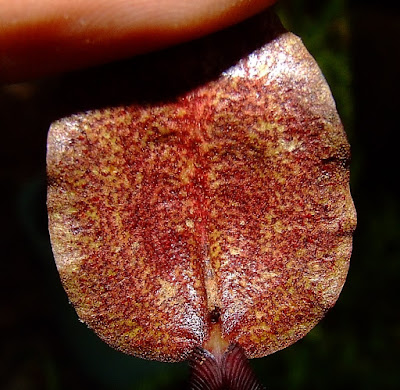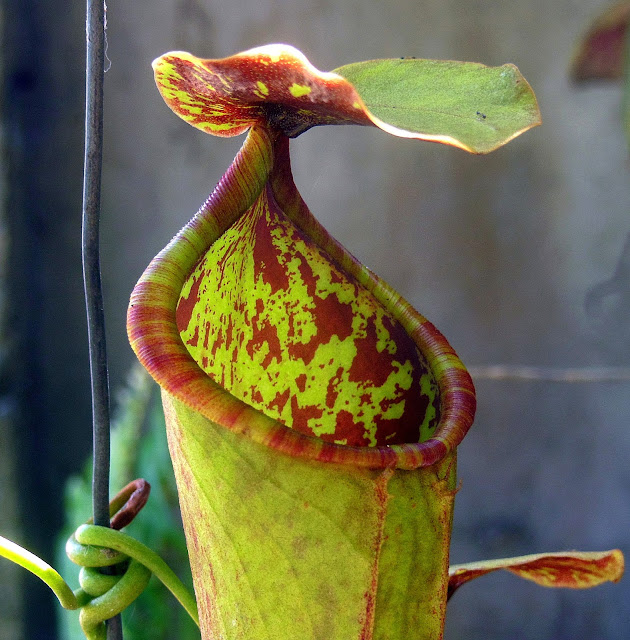The Sibuyan form of Nepenthes graciliflora
Nepenthes graciliflora was for many years considered conspecific with N. alata, a taxon previously interpreted to exhibit a very wide range of variations and occurring throughout the Philippines. But works by Drs. Matthew Jebb and Martin Cheek in recent years have elucidated the boundaries of N. alata's species concepts which ultimately resulted in the description of a number of species, some of which are controversial due to limited sampling, which is only confined mostly to herbarium materials. Nevertheless, the delimitation between N. alata and N. graciliflora is now fairly well clarified, with the latter taxon now taking up most of the distribution records previously ascribed to the former. Not surprisingly, N. graciliflora displays quite a good deal of variation, but how do we know how it really looks like and which ones can be considered variations? To answer that question, one has to look at plants from the locus classicus, or the place where the first specimens subsequently described scientifically were found. These specimens, known as the types, serve as the yardstick by which all later specimens will be measured up, to determine if these are referable to an earlier described name, or a new species altogether. In the case of N. graciliflora, the locus classicus is on Mt. Guiting-guiting on the island of Sibuyan. The type was collected by Adolph Daniel Edward Elmer on May 1910 along the Pauala River, at an altitude of about 1,000 ft.
The plant featured here is a N. graciliflora with a Sibuyan provenance. Sibuyan of course is known for four other Nepenthes species: N. argentii, N. armin, N. sibuyanensis, and N. ventricosa. Plants of N. graciliflora from Sibuyan have become sporadically available in recent years, and only vary in coloration but otherwise morphologically stable.
The shape of these plants differ from the more usually seen clones of the species from other localities, particularly from eastern and southern Luzon, by being less bulbous at the bottom.
The two photos below depict specimens of N. graciliflora from the province of Quezon. Note the very bulbous bases.
The lid glands of N. graciliflora are monomorphic ('with only one appearance'), un-bordered, and evenly distributed across the lid undersides.
To better illustrate what I meant by 'monomorphic' and 'un-bordered', consider the lid glands of N. mindanaoensis, shown below. You will see the minute, red glands distributed fairly evenly on the surface, and the larger, pustule-like glands along the edges of the lid. Because there are two types of glands present, the term applicable in this case is 'dimorphic', as opposed to monomorphic. If more than two types of glands are present, then the term would be 'polymorphic'. Note too the edges of the larger glands being raised and thickened; this is what we meant by 'bordered' glands.
Now compare the lid glands of N. alata. Like those of N. graciliflora. N. alata's are also monomorphic and unbordered. What distinguishes N. alata from N. graciliflora? The most easily seen trait in N. alata that isn't encountered on N. graciliflora is the indumentum, or the minute hairs, on its pitchers. Indumentum is also present in other plant parts of N. alata, including the stems and leaves. By comparison, N. graciliflora is glabrous- smooth and practically hairless.
Nepenthes graciliflora is an easy carnivorous plant in lowland to intermediate climates, and is adaptable and easy enough to even be recommendable to beginners in carnivorous plants. However, very few have the Sibuyan clones, which represents what we can call the 'real' N. graciliflora. Most material is sourced from Quezon, such as this all-green form:
Like other gracilifloras from other parts of its range, the Sibuyan clones also produce a multitude of pitchers, and one plant can have several active traps at once.
The plant featured here is a N. graciliflora with a Sibuyan provenance. Sibuyan of course is known for four other Nepenthes species: N. argentii, N. armin, N. sibuyanensis, and N. ventricosa. Plants of N. graciliflora from Sibuyan have become sporadically available in recent years, and only vary in coloration but otherwise morphologically stable.
 |
| A trio of N. graciliflora traps |
The shape of these plants differ from the more usually seen clones of the species from other localities, particularly from eastern and southern Luzon, by being less bulbous at the bottom.
The two photos below depict specimens of N. graciliflora from the province of Quezon. Note the very bulbous bases.
The lid glands of N. graciliflora are monomorphic ('with only one appearance'), un-bordered, and evenly distributed across the lid undersides.
To better illustrate what I meant by 'monomorphic' and 'un-bordered', consider the lid glands of N. mindanaoensis, shown below. You will see the minute, red glands distributed fairly evenly on the surface, and the larger, pustule-like glands along the edges of the lid. Because there are two types of glands present, the term applicable in this case is 'dimorphic', as opposed to monomorphic. If more than two types of glands are present, then the term would be 'polymorphic'. Note too the edges of the larger glands being raised and thickened; this is what we meant by 'bordered' glands.
Now compare the lid glands of N. alata. Like those of N. graciliflora. N. alata's are also monomorphic and unbordered. What distinguishes N. alata from N. graciliflora? The most easily seen trait in N. alata that isn't encountered on N. graciliflora is the indumentum, or the minute hairs, on its pitchers. Indumentum is also present in other plant parts of N. alata, including the stems and leaves. By comparison, N. graciliflora is glabrous- smooth and practically hairless.
 |
| Lid underside of N. alata. |
Like other gracilifloras from other parts of its range, the Sibuyan clones also produce a multitude of pitchers, and one plant can have several active traps at once.
 |
| Compared to the more usual clones of the species, the Sibuyan plants are more lithe. |










Comments
Post a Comment